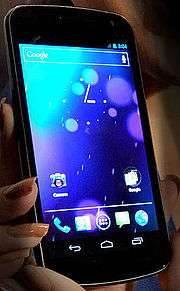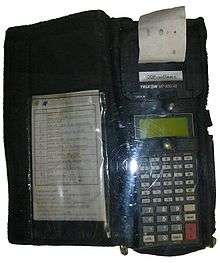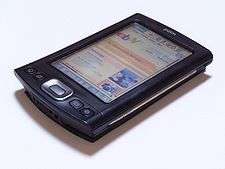Mobile computing


Mobile computing is human–computer interaction by which a computer is expected to be transported during normal usage, which allows for transmission of data, voice and video. Mobile computing involves mobile communication, mobile hardware, and mobile software. Communication issues include ad hoc networks and infrastructure networks as well as communication properties, protocols, data formats and concrete technologies. Hardware includes mobile devices or device components. Mobile software deals with the characteristics and requirements of mobile applications.
Principles of Mobile Computing
- Portability: Facilitates movement of device(s) within the mobile computing environment.
- Connectivity: Ability to continuously stay connected with minimal amount of lag/downtime, without being affected by movements of the connected nodes
- Social Interactivity: Maintaining the connectivity to collaborate with other users, at least within the same environment.
- Individuality: Adapting the technology to suit individual needs.
or
- Portability: Devices/nodes connected within the mobile computing system should facilitate mobility. These devices may have limited device capabilities and limited power supply, but should have a sufficient processing capability and physical portability to operate in a movable environment.
- Connectivity: This defines the quality of service (QoS) of the network connectivity. In a mobile computing system, the network availability is expected to be maintained at a high level with the minimal amount of lag/downtime without being affected by the mobility of the connected nodes.
- Interactivity: The nodes belonging to a mobile computing system are connected with one another to communicate and collaborate through active transactions of data.
- Individuality: A portable device or a mobile node connected to a mobile network often denote an individual; a mobile computing system should be able to adopt the technology to cater the individual needs and also to obtain contextual information of each node.
Devices
Some of the most common forms of mobile computing devices are:
- Portable computers, compact, lightweight units including a full character set keyboard and primarily intended as hosts for software that may be parameterized, as laptops, notebooks, notepads, etc.
- Mobile phones including a restricted key set primarily intended but not restricted to for vocal communications, as smartphones, cell phones, feature phones, etc.
- Smart cards that can run multiple applications but typically payment, travel and secure area access
- Wearable computers, mostly limited to functional keys and primarily intended as incorporation of software agents, as watches, wristbands, necklaces, keyless implants, etc.
The existence of these classes is expected to be long lasting, and complementary in personal usage, none replacing one the other in all features of convenience.
Other types of mobile computers have been introduced since the 1990s including the:
- Portable computer (discontinued)
- Personal digital assistant/Enterprise digital assistant (discontinued)
- Ultra-Mobile PC (discontinued)
- Laptop
- Smartphone
- Robots
- Tablet computer
- Wearable computer
- Carputer
- Application-specific computer
Limitations
- Range and bandwidth: Mobile Internet access is generally slower than direct cable connections, using technologies such as GPRS and EDGE, and more recently HSDPA, HSUPA, 3G and 4G networks and also the upcoming 5G network. These networks are usually available within range of commercial cell phone towers. High speed network wireless LANs are inexpensive but have very limited range.
- Security standards: When working mobile, one is dependent on public networks, requiring careful use of VPN. Security is a major concern while concerning the mobile computing standards on the fleet. One can easily attack the VPN through a huge number of networks interconnected through the line.
- Power consumption: When a power outlet or portable generator is not available, mobile computers must rely entirely on battery power. Combined with the compact size of many mobile devices, this often means unusually expensive batteries must be used to obtain the necessary battery life.
- Transmission interferences: Weather, terrain, and the range from the nearest signal point can all interfere with signal reception. Reception in tunnels, some buildings, and rural areas is often poor.
- Potential health hazards: People who use mobile devices while driving are often distracted from driving and are thus assumed more likely to be involved in traffic accidents.[1] (While this may seem obvious, there is considerable discussion about whether banning mobile device use while driving reduces accidents or not.[2][3]) Cell phones may interfere with sensitive medical devices. Questions concerning mobile phone radiation and health have been raised.
- Human interface with device: Screens and keyboards tend to be small, which may make them hard to use. Alternate input methods such as speech or handwriting recognition require training.
In-vehicle computing and fleet computing
Many commercial and government field forces deploy a rugged portable computer with their fleet of vehicles. This requires the units to be anchored to the vehicle for driver safety, device security, and ergonomics. Rugged computers are rated for severe vibration associated with large service vehicles and off-road driving and the harsh environmental conditions of constant professional use such as in emergency medical services, fire, and public safety.

Other elements affecting function in vehicle:
- Operating temperature: A vehicle cabin can often experience temperature swings from −30–60 °C (−22–140 °F). Computers typically must be able to withstand these temperatures while operating. Typical fan-based cooling has stated limits of 35–38 °C (95–100 °F) of ambient temperature, and temperatures below freezing require localized heaters to bring components up to operating temperature (based on independent studies by the SRI Group and by Panasonic R&D).
- Vibration can decrease the life expectancy of computer components, notably rotational storage such as HDDs.
- Visibility of standard screens becomes an issue in bright sunlight.
- Touchscreen users easily interact with the units in the field without removing gloves.
- High-temperature battery settings: Lithium ion batteries are sensitive to high temperature conditions for charging. A computer designed for the mobile environment should be designed with a high-temperature charging function that limits the charge to 85% or less of capacity.
- External antenna connections go through the typical metal cabins of vehicles which would block wireless reception, and take advantage of much more capable external communication and navigation equipment.
Security issues involved in mobile
Mobile security or mobile phone security has become increasingly important in mobile computing. It is of particular concern as it relates to the security of personal information now stored on the smartphone.
More and more users and businesses use smartphones as communication tools but also as a means of planning and organizing their work and private life. Within companies, these technologies are causing profound changes in the organization of information systems and therefore they have become the source of new risks. Indeed, smartphones collect and compile an increasing amount of sensitive information to which access must be controlled to protect the privacy of the user and the intellectual property of the company.
All smartphones, as computers, are preferred targets of attacks. These attacks exploit weaknesses related to smartphones that can come from means of communication like SMS, MMS, wifi networks, and GSM. There are also attacks that exploit software vulnerabilities from both the web browser and operating system. Finally, there are forms of malicious software that rely on the weak knowledge of average users.
Different security counter-measures are being developed and applied to smartphones, from security in different layers of software to the dissemination of information to end users. There are good practices to be observed at all levels, from design to use, through the development of operating systems, software layers, and downloadable apps.
Portable computing devices
Several categories of portable computing devices can run on batteries but are not usually classified as laptops: portable computers, PDAs, ultra mobile PCs (UMPCs), tablets and smartphones.
- A portable computer (discontinued) is a general-purpose computer that can be easily moved from place to place, but cannot be used while in transit, usually because it requires some "setting-up" and an AC power source. The most famous example is the Osborne 1. Portable computers are also called a "transportable" or a "luggable" PC.
- A personal digital assistant (PDA) (discontinued) is a small, usually pocket-sized, computer with limited functionality. It is intended to supplement and to synchronize with a desktop computer, giving access to contacts, address book, notes, e-mail and other features.
 A Palm TX PDA
A Palm TX PDA - An ultra mobile PC (discontinued) is a full-featured, PDA-sized computer running a general-purpose operating system.
- A tablet computer that lacks a keyboard (also known as a non-convertible tablet) is shaped like a slate or a paper notebook. Instead a physical keyboard it has a touchscreen with some combination of virtual keyboard, stylus and/or handwriting recognition software. Tablets may not be best suited for applications requiring a physical keyboard for typing, but are otherwise capable of carrying out most of the tasks of an ordinary laptop.
- A smartphone has a wide range of features and install-able applications.
- A carputer is installed in an automobile. It operates as a wireless computer, sound system, GPS, and DVD player. It also contains word processing software and is bluetooth compatible.[4]
- A |Pentop (discontinued) is a computing device the size and shape of a pen. It functions as a writing utensil, MP3 player, language translator, digital storage device, and calculator.[5]
- An application-specific computer is one that is tailored to a particular application. For example, Ferranti introduced a handheld application-specific mobile computer (the MRT-100) in the form of a clipboard for conducting opinion polls.[6]
Boundaries that separate these categories are blurry at times. For example, the OQO UMPC is also a PDA-sized tablet PC; the Apple eMate had the clamshell form factor of a laptop, but ran PDA software. The HP Omnibook line of laptops included some devices small more enough to be called ultra mobile PCs. The hardware of the Nokia 770 internet tablet is essentially the same as that of a PDA such as the Zaurus 6000; the only reason it's not called a PDA is that it does not have PIM software. On the other hand, both the 770 and the Zaurus can run some desktop Linux software, usually with modifications.
Mobile data communication
Wireless data connections used in mobile computing take three general forms so.[7] Cellular data service uses technologies such as GSM, CDMA or GPRS, 3G networks such as W-CDMA, EDGE or CDMA2000.[8][9] and more recently 4G networks such as LTE, LTE-Advanced.[10] These networks are usually available within range of commercial cell towers. Wi-Fi connections offer higher performance,[11] may be either on a private business network or accessed through public hotspots, and have a typical range of 100 feet indoors and up to 1000 feet outdoors.[12] Satellite Internet access covers areas where cellular and Wi-Fi are not available[13] and may be set up anywhere the user has a line of sight to the satellite's location,[14] which for satellites in geostationary orbit means having an unobstructed view of the southern sky.[7] Some enterprise deployments combine networks from multiple cellular networks or use a mix of cellular, Wi-Fi and satellite.[15] When using a mix of networks, a mobile virtual private network (mobile VPN) not only handles the security concerns, but also performs the multiple network logins automatically and keeps the application connections alive to prevent crashes or data loss during network transitions or coverage loss.[16][17]
See also
| Wikimedia Commons has media related to Mobile computers. |
- Enterprise digital assistant
- Location-based service
- Mobile cloud computing
- Mobile Computing and Communications Review
- Mobile development
- Mobile device management
- Mobile identity management
- Mobile interaction
- Mobile software
- Mobileers (users of mobile rigs)
- Smart device
- Ubiquitous computing
References
Footnotes
- ↑ http://www.distraction.gov/stats-and-facts/
- ↑ "Hands Free Cell Phones No Safer, Insurance Study Claims". Retrieved 16 July 2015.
- ↑ "Study: Distractions, not phones, cause car crashes". CNET. CBS Interactive. Retrieved 16 July 2015.
- ↑ "Carputer Articles on Engadget". Engadget. AOL. Retrieved 16 July 2015.
- ↑ "Gear Diary » The FLY Fusion Pentop Computer Review". 7 October 2007. Retrieved 16 July 2015.
- ↑ G Rowley, K Barker and V Callaghan “The Questronic Project and the Ferranti MRT 100 A Boon For Survey Research”, The Professional Geographer, Volume 37, Issue 4, pages 459–463, November 1985
- 1 2 "Wireless Data Communications for Beginners", Ositech
- ↑ Lachu Aravamudhan, Stefano Faccin, Risto Mononen, Basavaraj Patil, Yousuf Saifullah, Sarvesh Sharma, Srinivas Sreemanthula. "Getting to Know Wireless Networks and Technology", InformIT
- ↑ "What really is a Third Generation (3G) Mobile Technology", ITU
- ↑ LTE Advanced
- ↑ Gier, Jim. "Wireless Network Industry Report", Wireless Nets, Ltd.
- ↑ "Wi-Fi"
- ↑ Mitchell, Bradley. "Satellite Internet"
- ↑ "Introduction to Global Satellite Systems", CompassRose International Publications
- ↑ Case studies, netmotionwireless.com
- ↑ Phifer, Lisa. "Mobile VPN: Closing the Gap", SearchMobileComputing.com, July 16, 2006.
- ↑ Cheng, Roger. "Lost Connections", The Wall Street Journal, December 11, 2007.
Bibliography
- GH Forman, J Zahorjan - Computer, 1994 - doi.ieeecomputersociety.org
- David P. Helmbold, "A dynamic disk spin-down technique for mobile computing", citeseer.ist.psu.edu, 1996
- MH Repacholi, "health risks from the use of mobile phones", Toxicology Letters, 2001 - Elsevier
- Landay, J.A. Kaufmann, T.R., "user interface issues in mobile computing", Workstation Operating Systems, 1993.
- T Imielinski, BR Badrinath "mobile wireless computing, challenges in data management- Communications of the ACM, 1994 - portal.acm.org
- Roth, J. "Mobile Computing - Grundlagen, Technik, Konzepte", 2005, dpunkt.verlag, Germany
- Pullela, Srikanth. "Security Issues in Mobile Computing" http://crystal.uta.edu/~kumar/cse6392/termpapers/Srikanth_paper.pdf
- Zimmerman, James B. "Mobile Computing: Characteristics, Business Benefits, and Mobile Framework" April 2, 1999. http://ac-support.europe.umuc.edu/~meinkej/inss690/zimmerman/INSS%20690%20CC%20-%20Mobile%20Computing.htm
- Koudounas, Vasilis. Iqbal, Omar. "Mobile Computing: Past, Present, and Future" http://www.doc.ic.ac.uk/~nd/surprise_96/journal/vol4/vk5/report.html
Further reading
- B'Far, Reza (2004). Mobile Computing Principles: Designing and Developing Mobile Applications with UML and XML. Cambridge University Press. ISBN 0-521-81733-1.
- Poslad, Stefan (2009). Ubiquitous Computing: Smart Devices, Environments and Interactions. Wiley. ISBN 0-470-03560-9.
- Rhoton, John (2001). The Wireless Internet Explained. Digital Press. ISBN 1-55558-257-5.
- Talukder, Asoke; Yavagal, Roopa (2006). Mobile Computing: Technology, Applications, and Service Creation. McGraw-Hill Professional. ISBN 0-07-147733-0.